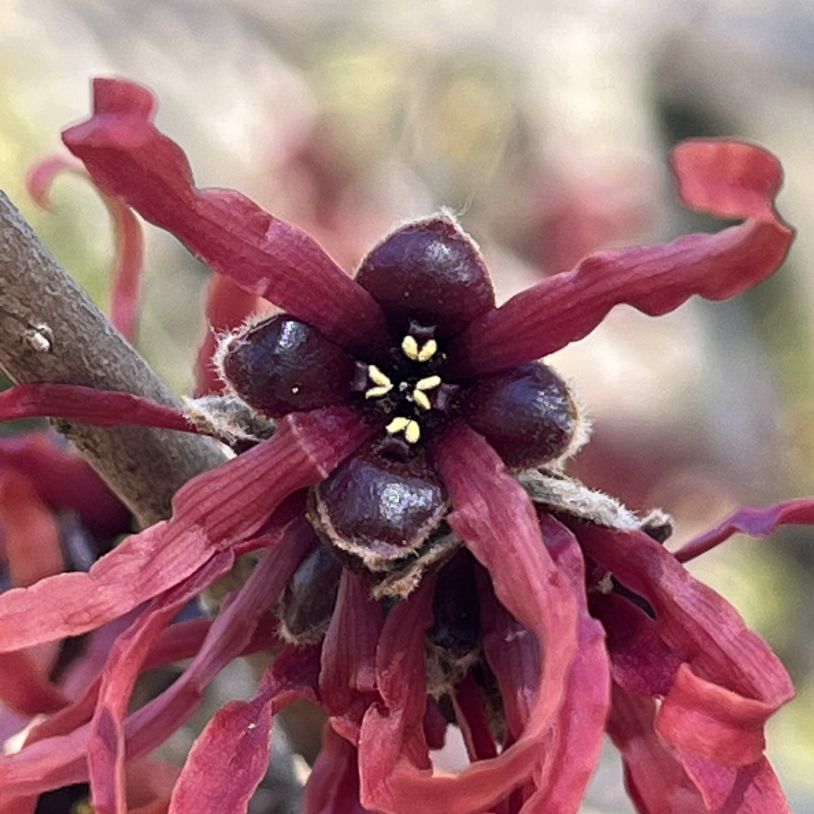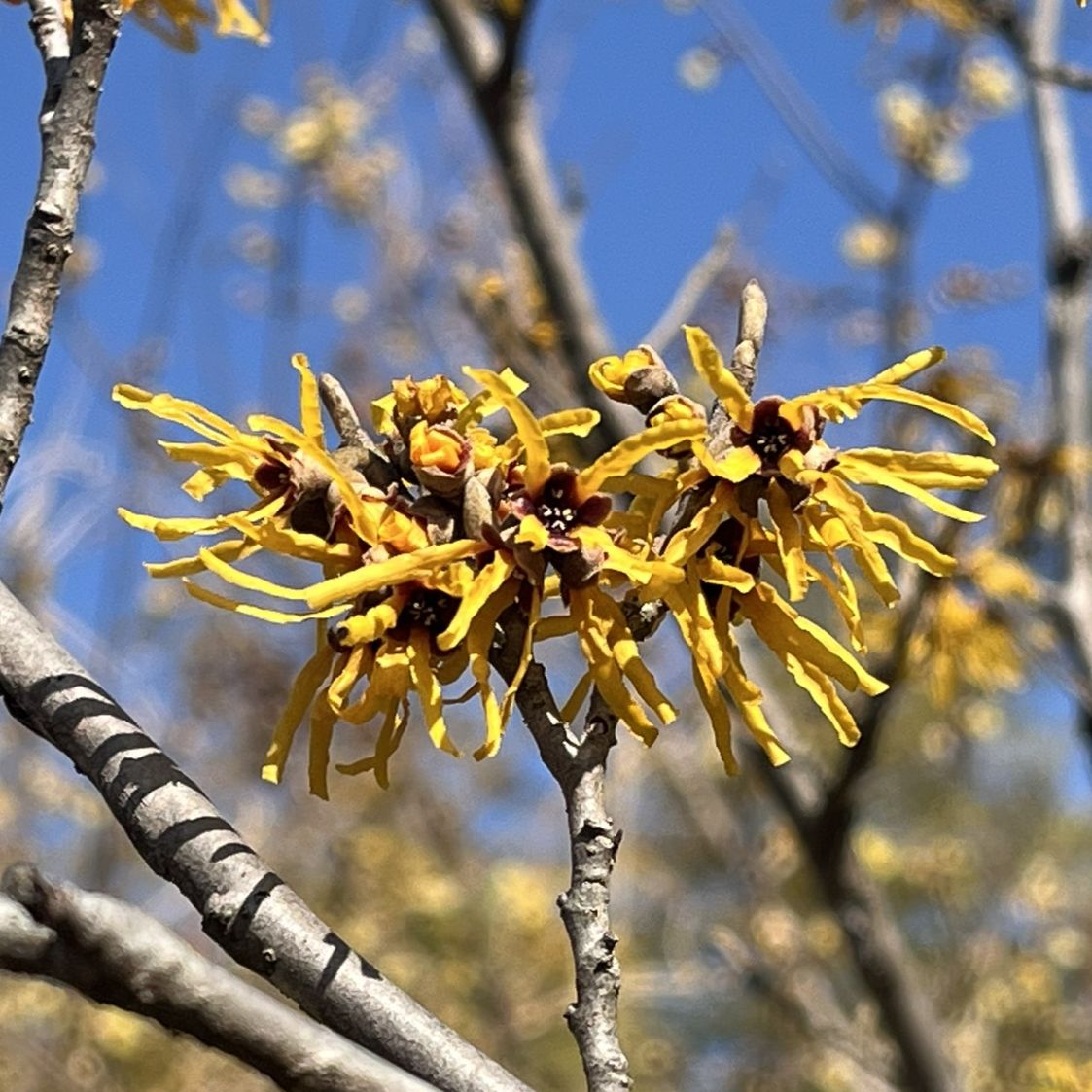マンサクの古名「粃」は実の入らない穀物を意味し、不作の象徴。そこに豊穣の願いを込めて「満作」「万作」と呼ばれるようになりました。
The old Japanese name for Japanese Witch Hazel means “empty grain” and was a symbol of poor harvest. With the hope of a good harvest, it has come to be called by a new Japanese name meaning “bountiful harvest”.
【仮名】マンサク
【和名】満作, 万作
【英名】Japanese Witch Hazel
【学名】Hamamelis japonica
【誕生】01/ 06, 01/ 08, 01/ 31, 02/ 12, 03/ 21
【開花】02, 03月
【花色】Red, Yellow, Orange
マンサク
マンサクの概要

マンサクはマンサク科の落葉小高木です。日本の本州から四国、九州まで太平洋側に分布し、山地で自生、庭園で植栽。古名「粃」は縮れた花の形に由来します。粃は実の入らない穀物を意味し、不作の象徴。そこに豊穣の願いを込めて「満作」「万作」と呼ばれるようになりました。
マンサクの名前

マンサクの名前の由来は春、他の木に先駆けて花が咲くから。「先ず咲く」の転訛です。英名ウイッチへーゼルは「魔女の榛」という意味。魔女の髪のように花が縮れ、榛のように木が霊力を持つと考えられました。ラテン語の属名ハマメリスは「西洋山査子に似ている」という意味。
マンサクの姿形

マンサクの樹皮は滑らかで、幹が灰色、枝が褐色です。花は丸い萼片が4枚、細い花弁が4本、短い雄しべと仮雄しべが4つずつ、雌しべが2裂。仄かに甘く香ります。葉は卵形で縁に粗い鋸歯があり、互生。葉身が左右非対称なので「片削げ」と呼ばれます。花後は硬い蒴果を形成。
マンサクの類縁

マンサクの変種「丸葉満作」は北海道南西部から本州の鳥取県まで、日本海側に分布。葉がやや小さく、丸みを帯びます。「錦満作」は花弁の基部だけが赤色、「赤花満作」は花弁全体が赤色。近縁種「支那満作」は花が早く咲いて香りが強く、「亜米利加満作」は花が秋に咲きます。
マンサクの利用

マンサクは観賞用のほか、葉がタンニンを含むため、火傷や湿疹、下痢などの薬に、肌の引き締めなどの美容に用いられました。強靭な枝は雪上歩行用の樏や、筏や薪の結束に、丈夫な樹皮は縄に。毎春、田の神様が山から戻るときの依代として、田んぼの縁で大切に育てられました。
Japanese Witch Hazel

Japanese Witch Hazel is a deciduous tree of the Hamamelidaceae family. It is distributed on the Pacific coast of Japan from Honshu to Shikoku and Kyushu, and grows wild in mountainous areas and is planted in gardens. The old Japanese name comes from the shape of the curled flower. It means “empty grain” and was a symbol of poor harvest. With the hope of a good harvest, it has come to be called by a new Japanese name meaning “bountiful harvest”.
The Japanese name for Japanese Witch Hazel means “bountiful harvest”, but it also comes from the expression “flowers bloom in spring before other trees”. The English name comes from the fact that the flowers curl like a witch’s hair and the tree was thought to have spiritual power like a hazel. The Latin genus name Hamamelis means “resembling a Western hawthorn.”
The bark of the Japanese Witch Hazel is smooth, the trunk is gray, and the branches are brown. The flower has four round sepals, four thin petals, four short stamens, and two-lobed pistils. It has a faintly sweet fragrance. The leaves are ovate with rough sawtooth edges and alternate. The leaf blade is asymmetrical. After flowering, a hard capsule forms.
The Japanese Witch Hazel variety “obtusata” is distributed along the Sea of Japan coast from southwestern Hokkaido to Tottori Prefecture in Honshu. The leaves are slightly small and rounded. In “flavo-purpurascens,” only the bases of the petals are red, and in “incarnata,” the entire petals are red. The closely related species “Hamamelis mollis” flowers early and has a strong fragrance, while “Hamamelis virginiana” flowers in autumn.
In addition to being used for decoration, Japanese Witch Hazel’s leaves contain tannins, so they were used as medicine for burns, eczema, and diarrhea, and for skin tightening and other beauty purposes. The strong branches were used to make lumber for walking on snow, for rafts and to tie firewood together, and the sturdy bark was used for ropes. And every spring, it was carefully grown on the edge of rice paddies as a place for the rice field god to reside when he returned from the mountains.



